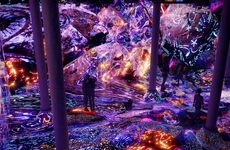
Astronomy Videos from The New Scientist
karl burkart — September 18, 2008 — Science
References: space.newscientist
The New Scientist just released a bunch of amazing scientific simulations courtesy of NASA/Swift/Cruz deWilde of a variety of cosmic events. The video above shows how astronomers think light from a gamma-ray burst called 080319B was released. A narrow jet punched though the outer layers of a collapsing star, then followed by a wider, less energetic beam.
Enough data has been collected from the Hubble (and other) telescopes and computer simulations are sophisticated enough now to visualize some of the universe’s great mysteries.
Enough data has been collected from the Hubble (and other) telescopes and computer simulations are sophisticated enough now to visualize some of the universe’s great mysteries.
Trend Themes
1. Sophisticated Cosmic Simulations - Innovative use of computer simulations is advancing the visualization and understanding of the universe’s complexities.
2. Astrophysics Animation - Animation is an effective medium to illustrate complex and dynamic space events, and promote STEM education.
3. Remote Space Observation - Space observation through remote telescopes is a growing and accessible field for amateur and professional astronomers alike.
Industry Implications
1. Astronomy and Space Research - The development of advanced computer simulations and animation is driving innovative space exploration and better understanding of Earth and the universe.
2. Education - Cosmic simulations are inspiring and effective teaching tools that promote scientific literacy and engagement.
3. Technology - The need for increased computer processing and storage capacity for sophisticated simulations and data analysis presents great opportunities for the technology industry.
2.5
Score
Popularity
Activity
Freshness















